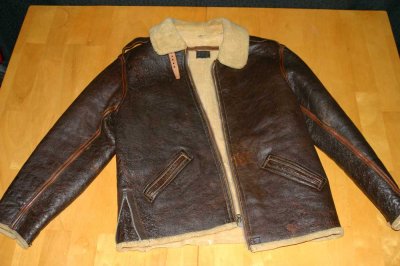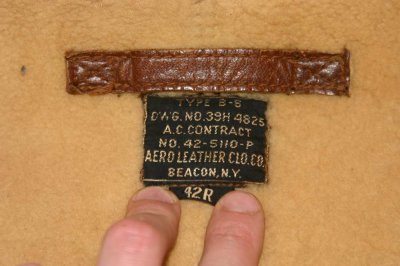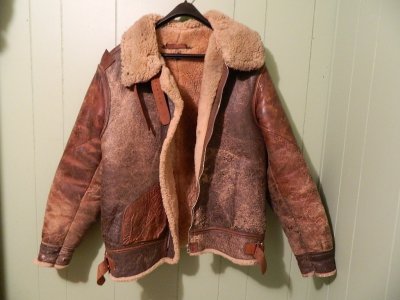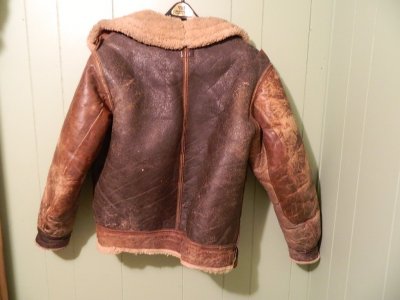mr_lits
A-List Customer
- Messages
- 319
- Location
- Los Anchorage
Yeah, wow both supremely nice examples.
 John Lofgren Monkey Boots Shinki Horsebuttt - $1,136 The classic monkey boot silhouette in an incredibly rich Shinki russet horse leather.
John Lofgren Monkey Boots Shinki Horsebuttt - $1,136 The classic monkey boot silhouette in an incredibly rich Shinki russet horse leather.  Grant Stone Diesel Boot Dark Olive Chromexcel - $395 Goodyear welted, Horween Chromexcel, classic good looks.
Grant Stone Diesel Boot Dark Olive Chromexcel - $395 Goodyear welted, Horween Chromexcel, classic good looks.  Schott 568 Vandals Jacket - $1,250 The classic Perfecto motorcycle jacket, in a very special limited-edition Schott double rider style.
Schott 568 Vandals Jacket - $1,250 The classic Perfecto motorcycle jacket, in a very special limited-edition Schott double rider style. What makes American jackets like the B-6 and B-3 so fragile? Is it construction or the type of sheepskin generally used?
I wouldn't go so far as to call it a nightmare, but the old adage "good things don't come easy" crosses my mind. I have to agree with you on the favorite sheepskin, but it is a close call between the B-6 and D-1 as well. Heck, I think all the wartime sheepskins are iconic jackets in their own right.
What makes American jackets like the B-6 and B-3 so fragile? Is it construction or the type of sheepskin generally used?
Here are a few photos from my B3 photo archive of some mixed batch jackets. You know when comparing them against Eastmans Mixed Batch. The details from color to cut are pretty darn good.
The answer is a bit all over the place. The D-1 B-6s were made out of thinner trimmed shearling and were generally not as robust. High demand of sheepskin meant using all of the materials (sometimes not the highest quality). And finally the tanning methods were certainly not made for archival purposes. Add in 70 years of usually poor storage or heavy use. Shake over ice and pour into a chilled glass.
Another mint example of a redskin B-3 which used to be in my collection. This one dates to the 1938 fiscal year and was made by Phillip's Tanning & Co. The skins show how close the redskin panels are on the Perry.
A politician might answer ' what evidence do you have they did ? '!
No seriously, we all know that materials change over time. Leather dries out, it wrinkles and it hardens to give the characteristic look that we all love so much. They are truly stunning jackets but I have found that most people seem to need to go up a size to get a comfortable fit which I suspect is because the materials are somewhat inelastic compared to those used before the Broken Grain variety.
I hate to somewhat disagree, but it's really mostly about the actual sheepskin quality and also the tanning process that was changed in 1942. The AAF and USN did not grant any dispensation to allow lower-grade sheepskin to be employed in order to generate more sheepskin flying suits more quickly and in greater numbers (they did do this with respect to the D-1/B-1 Mechanic's suits, but this had more to do with the non-flying status of the wearer than meeting demands). Poor garment design and change in the type of core seal lacquer also played some role in the fragility of the garments. The very worst scenario in an AAF sheepskin flying garment is one made from low-quality skins, tanned in the manner most were by late 1942, and then re-dyed by the AAF service depots at some later date. This would be the stuff that's really dry and crispy to touch - one good tug and it's done!
As for the B-6s, these indeed lack the reinforcing leather of a B-3, AN-J-4, M-445, etc., but if made from quality skins and stored correctly, they are just fine today. The problem is the small numbers made with respect to the B-6 and most being produced from the bad stuff. Once again, a pre-1942 redskin B-6 should largely be fine if it was correctly stored, it's just that these are so really few and far between. I do own a 1942 B-6 made from the skins I mentioned that were dried on metal grates and it's superb in every way, but I've seen all of two of such B-6s in over three decades of looking for such jackets.


That's a fine, fine B-6 you sold. Mine is from the same contract and I'm wondering if the skins on your former B-6 are from that same tannery whose skins have the markings of the metal drying grate impressed in them, thus being the most pliant, durable skins I've ever seen in the dark brown color. Was your jacket pretty pliant and soft overall?Excellent info. I have owned many sheepskins as well and had noticed that the lacquer jackets seemed worse off in general. Even a really broken in redskin seems to have faired better over the years than the brown ones!
Also sadly enough I just sold the finest example of a B6 I have ever seen. Though it was a bit flakey, it was without rip and still quite resilient. Hard to let go of. Usually when you find 'em they are shredded.
View attachment 28298 View attachment 28299
That's a fine, fine B-6 you sold. Mine is from the same contract and I'm wondering if the skins on your former B-6 are from that same tannery whose skins have the markings of the metal drying grate impressed in them, thus being the most pliant, durable skins I've ever seen in the dark brown color. Was your jacket pretty pliant and soft overall?
The skins on my B-6 have the wool color much more muted than yours; it's not soling, but just lacking the luster and deeper, buttermilk color I see in yours, which looks so wonderful.


Yes, you could see the grate marks on many of the panels. The leather was still quite supple and pliable but the front two panels less so. When I received it years ago I gave it a few rub downs with 100% pure lanolin (the only treatment I use on my leathers) and that brought back much of the suppleness lost over the years.
Thank you for the Information HPA Rep. :eusa_clap
And Just while we are on the Subject. I realize this is not a perry sportswear Item itself but;
Here is a well loved 46R Mixed batch Aero Jacket *BEFORE* I bought it.
It came from Wyoming and the front pocket was full of Hay, also There was Much horse grime on the Sleeves and I am presuming the Marlboro man himself must have Rode with this thing, With a Real Cowboy hat and All for a long time after the war. Would have been the Jacket I would use on some Campy nights on the range myself. Perfect for those Cold nights rounding up the Herd.
Was Tricky to Tell by studying these photos it was a Mixed batch without a Keen Eye because of how Dry the cuts are.
It is By far the Most Robust Jacket I own.
Andrew Says its a 1941 Jacket.
The back panels are JUST INCREDIBLY DENSE!!!
I will play Dress-up for all you fine gents and take a few Snaps in the upcoming week for those looking for a Nice Ref. to a time worn Piece such as this.
Thank you. You confirmed my suspicions, as I thought I saw some of the grate marks in the one photo. That sheepskin so marked is the best of the dark brown skins you'll ever find, in terms of suppleness and overall longevity. I've seen nicely worn jackets in this hide type and even they are quite good compared to most of what we see in the dark brown skins, but when you find a superb example made of these skins, it's like new. My B-6 of this contract is more supple than a new example from Eastman, I kid you not, which may have more to do with the vintage B-6 having been worn a little. And my HLB B-3 with goatskin sleeve reinforcements is absolutely never worn and mind blowing. Other than obviously devaluing any such superb jackets by wearing them, I'm fully convinced such examples would be wearable and the skins themselves would not split or crack, though cotton thread that's over 70 years old likely isn't going to do well, so splits on sewn seams would likely occur.
I've only seen these grate marks on sheepskin flying suits made by Aero and HLB early in 1942, which doesn't mean it wasn't used by other contractors, but I'm thinking it was a specific batch(es) from early 1942 by one tannery and all were shipped either directly to the tanneries (as was almost always the case) or to a northeastern air supply depot, where the skins were then sent to these New York-based contractors.
Oh, while I have your attention, please note what brand of lanolin you like; I've been wanting to try some. Thank you!